► Exclusive LaFerrari Aperta review
► One day to test the £1.9m hypercar
► Prices, specs and full verdict
The official car of Ferrari’s 70th year is the LaFerrari Aperta, an open-top hypercar with a single purpose: to remind the world that nobody does automotive hedonism better than Enzo’s squad.
CAR magazine was granted the only officially sanctioned factory test drive for our Ferrari 70th anniversary special issue in January 2018. Read on for our full LaFerrari Aperta review and enjoy the brilliant photography by Steffen Jahn.
8.37am Ferrari’s media offices, Maranello
Another espresso, another presentation slide – welcome to Ferrari’s briefing for LaFerrari first-timers. There are many slides because the LaFerrari is not a simple car. There’s a substantial chapter on the hybrid powertrain alone (an alliance of turbo-free 789bhp, 6.2-litre V12 and mild hybrid KERS system for a fulsome 950bhp, as per 2014’s coupe). It’s captivating stuff and intuitively Ferrari knows that you want absolutely everything, and in forensic detail – the LaFerrari is that kind of a car.
As the hands of the clock on the wall spin in double-time, I realise that I am getting absolutely everything, and in forensic detail. Exactly when and to what extent the ECU preloads the V12, holding it taut like a sprinter’s calves to both recharge the battery and to have it ready the very moment you are. I learn just how much stiffer the carbon monocoque is than the Enzo’s (27 per cent, though it’s also 20 per cent lighter) and the pretty niche pub quiz nugget that around the Fiorano test track dropping a car’s centre of gravity 30mm is worth 0.3sec, the same as a 38bhp power increase.
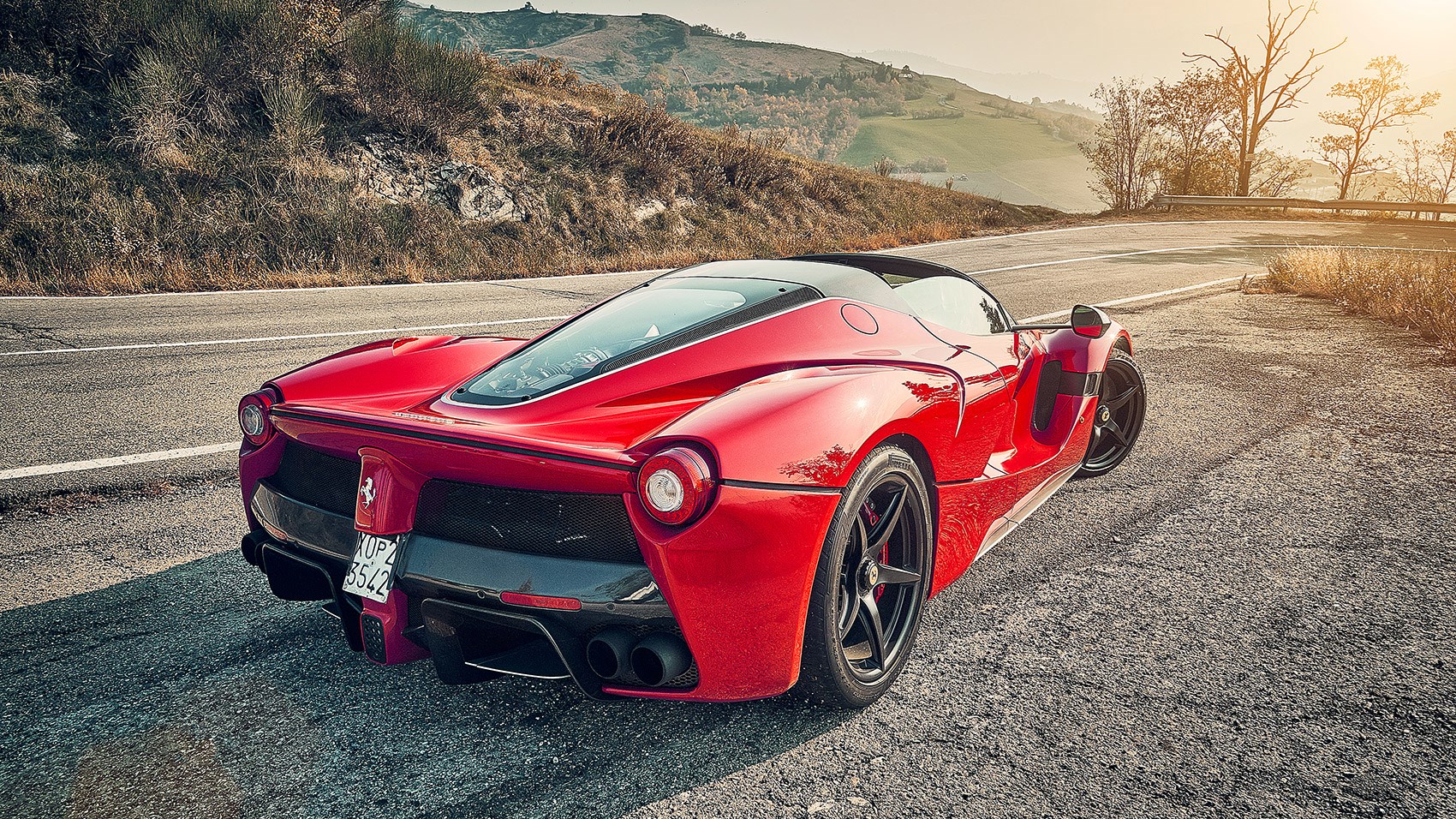
Matteo Lanzavecchia is the Ferrari engineer tasked with bringing brains less dexterous than his own up to speed. He delights in every detail of the LaFerrari’s uncompromised engineering, and he knows the car and his presentation inside-out. But he faces two challenges. The first is that the car waiting for me outside is a LaFerrari Aperta, which his presentation doesn’t cover. It hasn’t had to – there were never any plans to let journalists drive the limited-edition Aperta. I will be the first.
There are no slides for it, so he must talk me through how Ferrari re-engineered their hypercar to run without roof. (In short, repositioned radiators, a new aero package re-routing the airstream from over the cockpit to under and around it, powertrain management systems upgraded with lessons learned from the coupe and a re-engineered carbon tub just as resistant to twist despite the absent roof.)
And there’s another problem. Again, the car waiting for me outside is a LaFerrari Aperta. It is the embodiment of all that the world’s most celebrated car maker has learned about performance engineering since 1947. Dedicate decades of effort and expenditure to the art and science of creating extraordinarily fast and beautiful cars, their every concept, curve and cam profile proven and gilded with glory in motorsport’s most fiery crucibles, and you end up here, with a car so exciting even Ferrari’s professionally dour security guards are giggling like school children. Fascinated as I am by Lanzavecchia’s slides, I’m guilty of a wandering mind.
What’s more, luck has piled itself upon luck to a quite improbable degree. The first days of November are doing a fine impression of mid-July. Across the road, the Scuderia’s glittering Formula 1 headquarters are bathed in warm morning sunlight, a benign mist sits on the hills beyond and the sky is alight with an unbroken, luminescent blue. Matteo, my man, could we wrap this up?
9.42am Ferrari’s front gates, Maranello
‘Give me a place to stand and I shall move the earth,’ said Archimedes. The bearded brain was making a point about the might of the mechanical lever, but his words feel oddly appropriate when you lift open the Aperta’s door and, with your heart bouncing off its rev limiter, put one hand on the driver’s headrest and lower yourself in. (Easier than you might imagine; the glossy black carbon sills curve in dramatically as they run forward to the nose.)
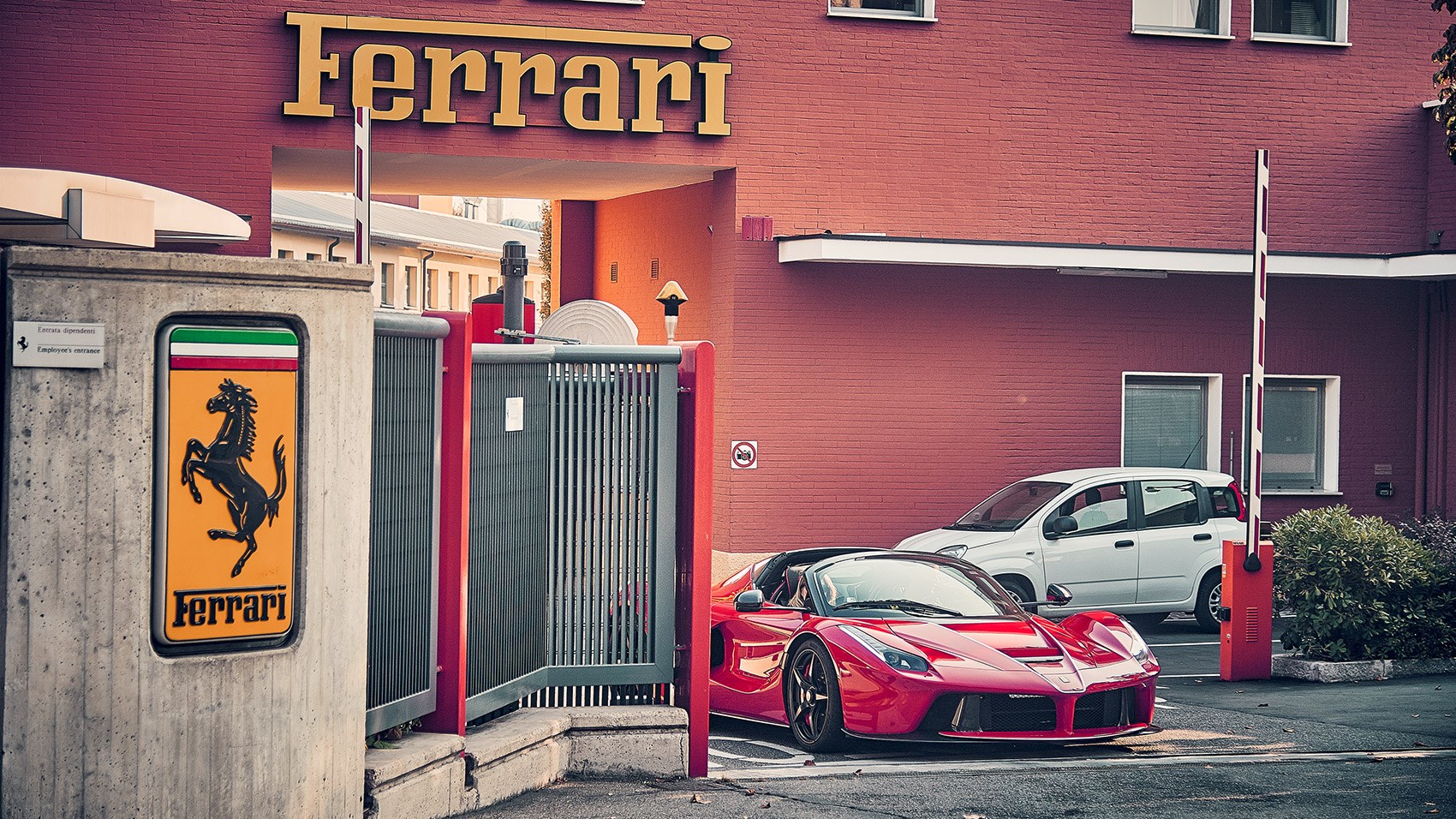
At this point you expect to surrender all meaningful control as nerves overrun your motor system, your cool obliterated by the Aperta’s intimidating numbers. (Earlier this year one sold at auction for £7.5 million, a record for a new car.) But the truth is that as you wriggle down into the seat, secure the four-point harness (one central buckle, drawing together waist and shoulder straps complete with cute Ferrari badges) and bring the steering wheel out to your chest, the complete opposite happens.
So brilliantly resolved is the Aperta’s driving position and so familiar its controls to anyone who’s driven a 488 that your palms dry out, your heart rate drops to merely aroused and those waves of panic settle to a becalmed sea of quiet confidence. This, you realise with a smile, is going to be okay.
The seat – little more than a series of pads set into anatomically sculpted reliefs in the carbon tub, to lower the roofline and the car’s centre of gravity – is an ergonomic triumph. The odd, vaguely square wheel can be pulled just as close as you want and, in a Schumacher style, it has upon it all that you need, notably the indicators, the manettino drive mode control and the button for bumpy road mode, to cut the dampers some slack on Emilia-Romagna’s subsidence-ravaged roads.
As per the 488, reverse and the button to go between manual and automatic shifting sit on a curious blade of carbonfibre between the seats. Really expensive looking air vents like little metal Death Stars swivel in their sockets with just the right amount of friction; enough to hold their position when you’re giving it death around Fiorano but never stiff. This lot, you’re tempted to conclude from the vents and driving position alone, are good. Ferrari has, by deploying all that it’s learned about the man/machine interface, given you a place to stand. Now, move the earth.
10.37am The SS12 south
There is no gap but the BMW X5 in my mirrors passes nonetheless, forging a path past me, past the cars ahead, past the truck in front of the cars ahead and on to glory or oblivion on faith alone. I wince and the Aperta does the same, its slack-free steering translating my every movement, voluntary or otherwise, into a change of course. The rack is so fast, the LaFerrari’s front end so responsive, that I’m still struggling to adjust as we trundle south on trunk roads seething with commuter traffic and edgy with inelegant overtaking. But even at this speed, with loads so light you sense the car doesn’t quite know what to do with itself, the LaFerrari’s steering stands out as special, and my new best friend.
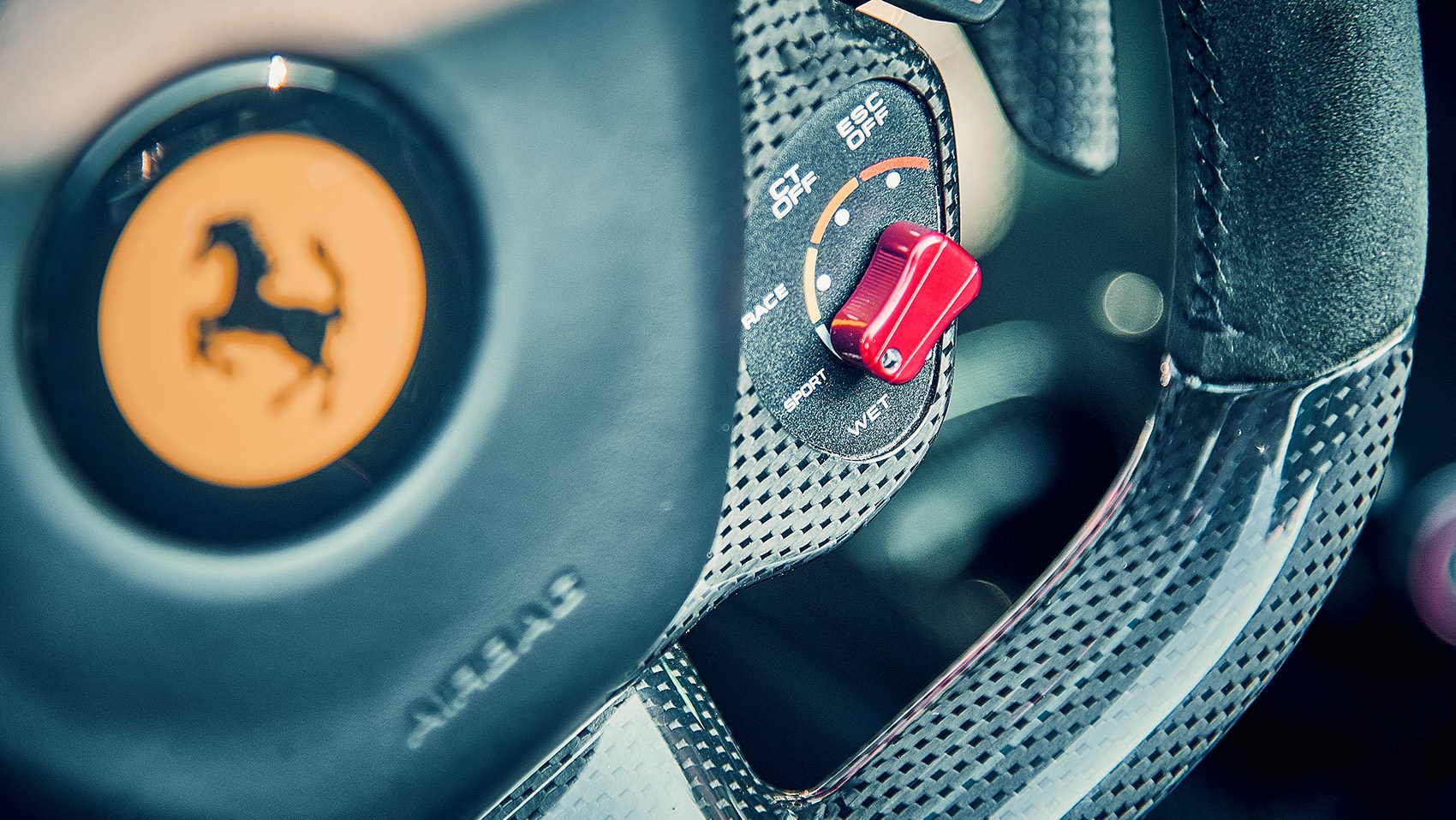
The manettino’s in the tamest of its dry settings, Sport, bumpy-road mode is engaged and the gearbox (conspicuously fabulous, even driving in this most un-Ferrari way) is imperceptibly doing its thing. Refined? Comfortable? Like you wouldn’t believe. Of course, with the V12 and hybrid system behind you and the soft roof stowed in the nose (I left the removable hardtop back at base – there shall be no rain) there’s absolutely nowhere to put anything, but in every other regard the Aperta is remarkably easygoing. The ride is astonishingly pliant, the powertrain effortless and, even with the cockpit open to the heavens, you can talk at 60mph without shouting.
The traffic begins to thin out and, as the road climbs, the Aperta soars past slower traffic on sinuous overtaking lanes. With the powertrain’s electric motor forever ready, there’s no need to drop gears to pass but you do so regardless, so satisfying are the clipped action of the vast, column-mounted shift paddles and the V12’s acoustic range as you play with revs, gears and load.
Running alone now as the SS12 winds on through the hills, there’s a dream-like quality to our progress. Power brings luxury, and there is a bewitching decadence to the LaFerrari’s outrageous excess of power. The fast-scrolling view through the vaguely Group C bubble-screen is beautiful, the rich winter sun playing across a voluptuous landscape of wild hillsides and river-washed valleys.
Great flurries of brittle autumn leaves tumble across the road and, behind us, plume into the air in the Aperta’s wake, CFD and wind tunnel-sculpted as it is. And without a roof the Aperta filters none of it; the sun’s warmth on your face, the cut-glass air tugging happy tears from your eyes and the sublime V12 all over your ears and your soul.
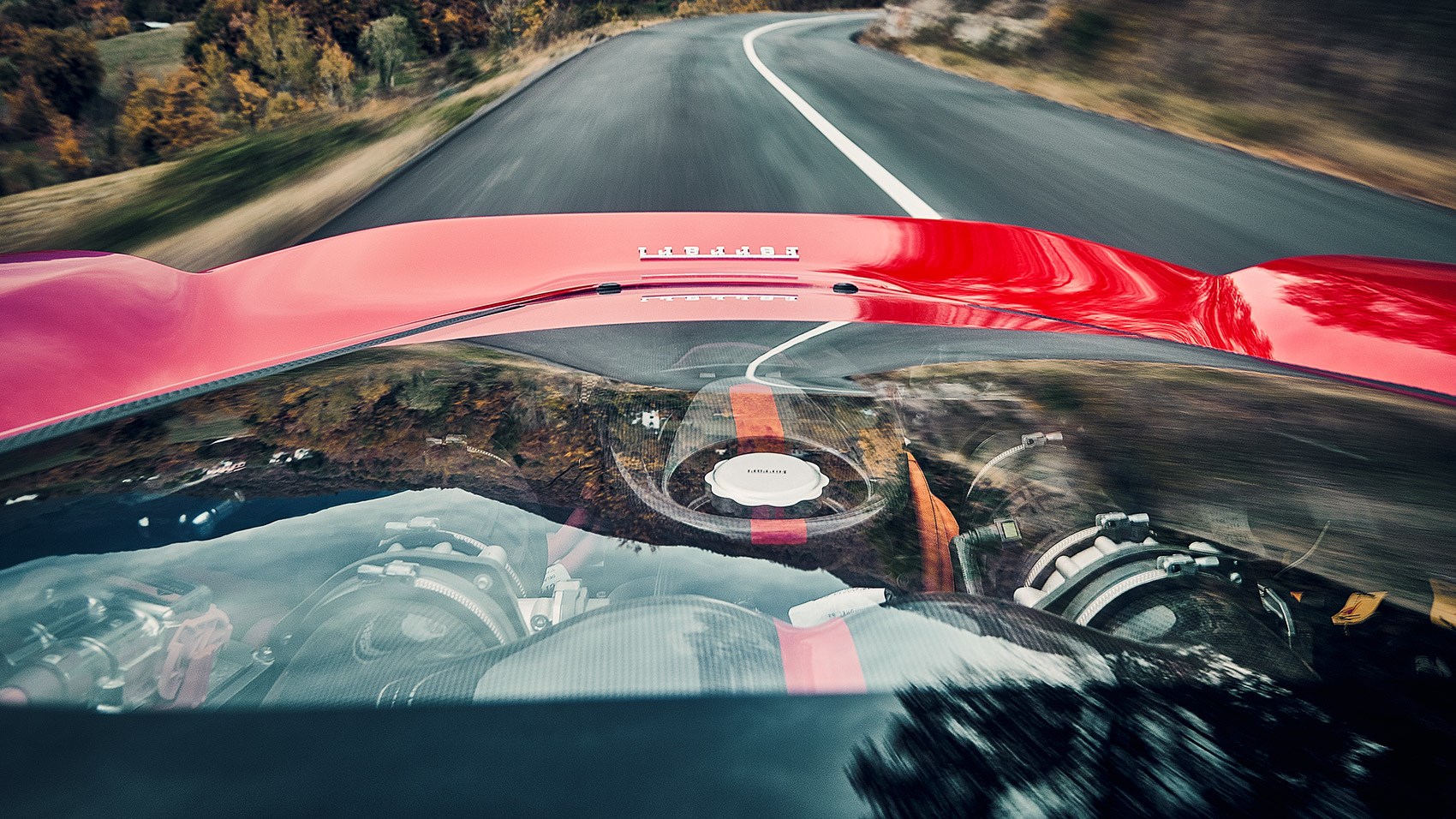
The finest engine currently in production? Has to be. Less a collection of castings and more a kind of barely contained lifeforce, its economies of scale precluding automation and granting an individual technician the honour of hand-assembling each one over three days and across five spotlessly clean workstations.
11.34am: The pretty special SP30
We turn off the main road and drop down onto the SP30, a road that looks like heaven on a map but may yet prove hellish. The Mk2 Golf ahead takes the same turn but holds me up for fewer than three corners. With a sliver of a gap the Aperta leaps ahead, its powertrain alive to my every whim. The car’s rate of response to my right foot is exhilarating, as instantaneous as the steering and every bit as life-affirming once you’ve recalibrated your brain to suit.
Ferrari’s target was a response time, to full throttle at 2500rpm in fourth gear, less than half that of the F12’s, then the flagship front-engined V12. For the LaFerrari it claims 0.1sec from foot down to 90 per cent of the engine’s full shove, versus 0.3sec for the F12, itself no slouch.
Three miles in there’s a gaggle of houses on a hilltop and a roadblock, though I’m flagged down not by carabinieri but three old boys, smiles plastered across weathered faces the colour of caramel, their crash-stopped Panda idling diagonal across the road. We’ve no common language but you don’t need Google Translate for the joy on their faces, and with hand gestures they ask me to sit tight for a moment while one summons his grandson.
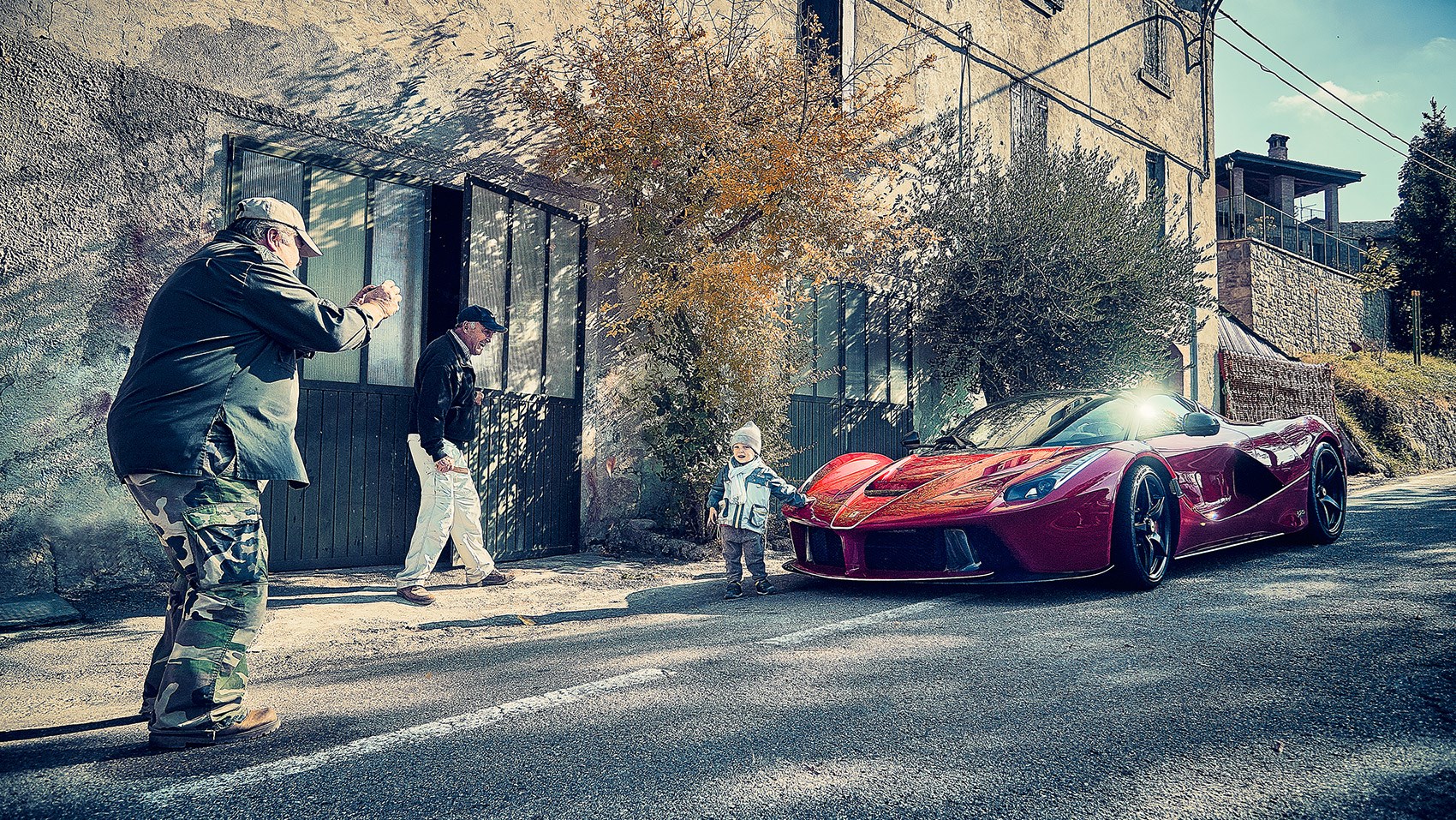
The little guy’s face is a picture as he runs podgy little fingers across warm scarlet paint. If Ferrari can hang onto nothing else over the next 70 years it can’t let this go: its cars’ unique ability to spontaneously prompt uncomplicated joy and wonder wherever they roam.
On into the endless string of hairpins that will, over the next minute or so, take the Aperta and me from high on the ridge to the valley floor below. Things start happening very quickly. The car can summon all the speed you could ever dream of – and often quite a bit more – in an instant. Its carbon-ceramic brakes are, somehow, at the very least just as mighty, combining a lightness of touch at the pedal with the kind of braking that tests your mortal form at a molecular level.
Given the complexity of the regenerative braking system the linear, intuitive feel at the pedal is a miracle; as well-resolved as the similarly hybrid and polished Honda NSX. (The LaFerrari effectively splits the system front/rear, so you feel the uncorrupted front end while the ECU juggles brakes and regeneration at the rear.) But the most astonishing rate of change with the Aperta isn’t even physical: it’s the speed with which you become comfortable with the measured violence of its performance.
We’re soon into an outlandishly quick rhythm, clicking up through second and third gears as the road flows along the hillside, my brain apparently unable to hold out beyond 6000rpm even though the redline’s at 9000rpm. Then it’s back to first gear for each gorgeous, generously cambered hairpin. What happens next is a kind of physical poetry, the front of the car rotating into the corner with surreal ease and adopting my chosen line to the inch.
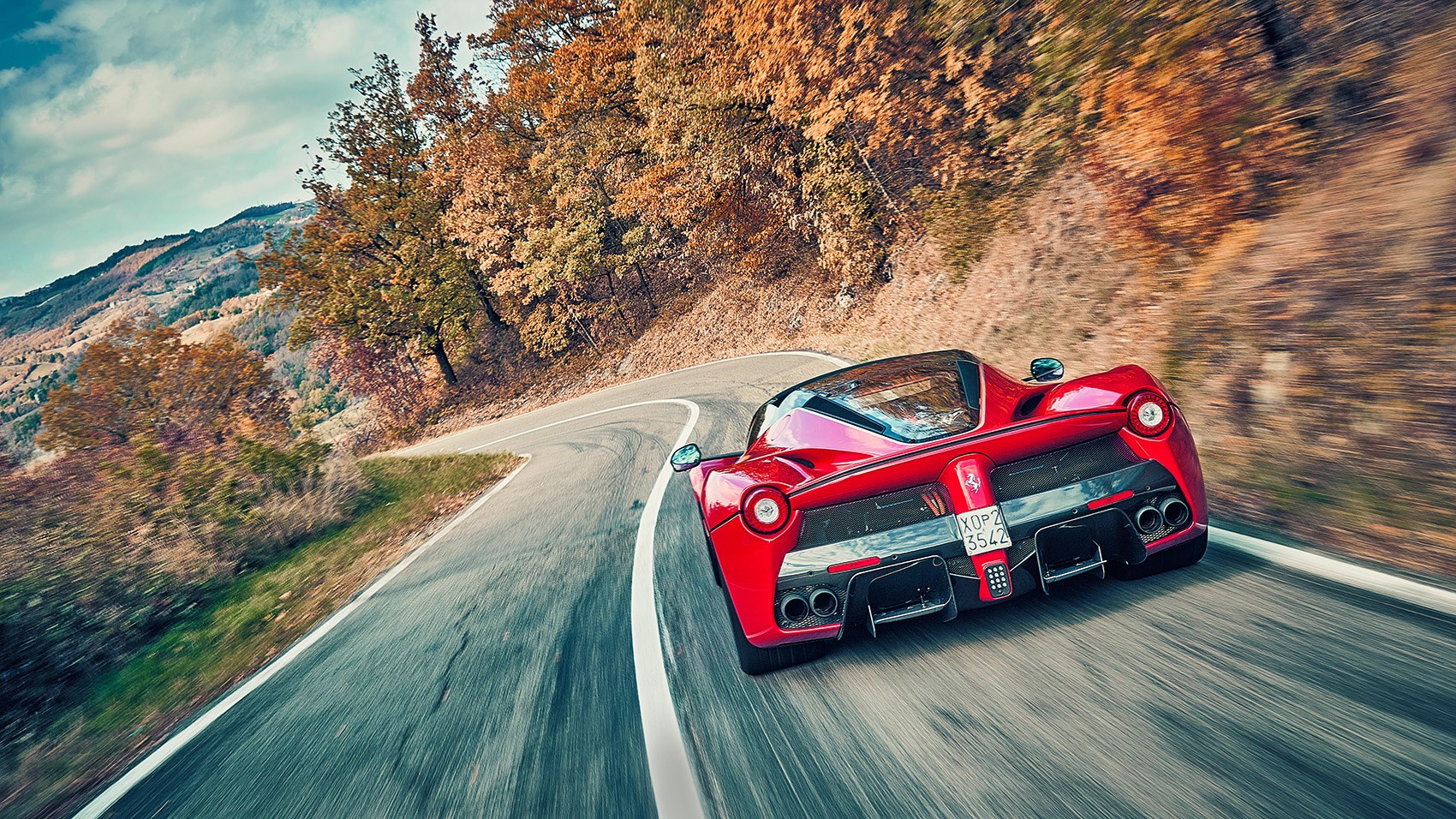
Thereafter the Aperta corners so level, so hard and so accurately it might be suspended in some perfectly oiled mechanism calibrated to thousandths of an inch. Worryingly this composure breeds huge confidence, and it’s not the dumb belief born of sheer grip either, though the Ferrari’s now hot Pirellis bring that. No, it’s the confidence that comes with knowing exactly what the car’s doing, how hard it’s working and how much more it has to give.
Maybe it’s the ultra-rigid tub, maybe it’s the fastidiously balanced weight distribution. Whatever, it’s soon clear the Aperta isn’t just one of the fastest, most exciting cars I’m ever likely to drive. It’s also one of the friendliest, like an F1 powertrain somehow shoehorned into an Elise. I wasn’t expecting that.
On we power, our furious pace unspoiled by traffic, meddlesome social conscience or the notion that I should in some way ease myself in, and save the proper drive for next time. There will be no next time – of that I can be pretty certain.
2.47pm, on the rubber-scarred SP26
Two squiggles of road half an hour apart. The LaFerrari breezes the unspectacular drive between the two with easy speed. Its remit is well beyond mere transport and yet, providing you’ve just the one friend and no worldly possessions, the Ferrari works brilliantly when you just need to get somewhere. The ETA on the nav tumbles like a wingless glider, its calculations barely able to keep up with the rate at which the Aperta moves across the landscape. So adept is the car at arcing through corners that, at this vaguely legal cross-county lick, I stop bothering to brake for them.
In what feels like moments we’re at the SP26, the dark scars arcing from its every apex testament to its status as a firm favourite with Ferrari’s development drivers. I know I have less than an hour left with the Aperta – that all too soon I must point it back to Maranello and, for the last time in my life, shut down its hot V12.
I can’t explain why, given the car’s value, my decidedly average skill at the wheel and the potential for infamy in being not only the first writer to drive a LaFerrari Aperta but also the first to scatter one across a quiet stretch of strada provinciale in a plane crash of splintered composites, but I decide nonetheless to nudge the manettino around first to Race and then to CT Off, and to make like Gilles for the top of the hill.
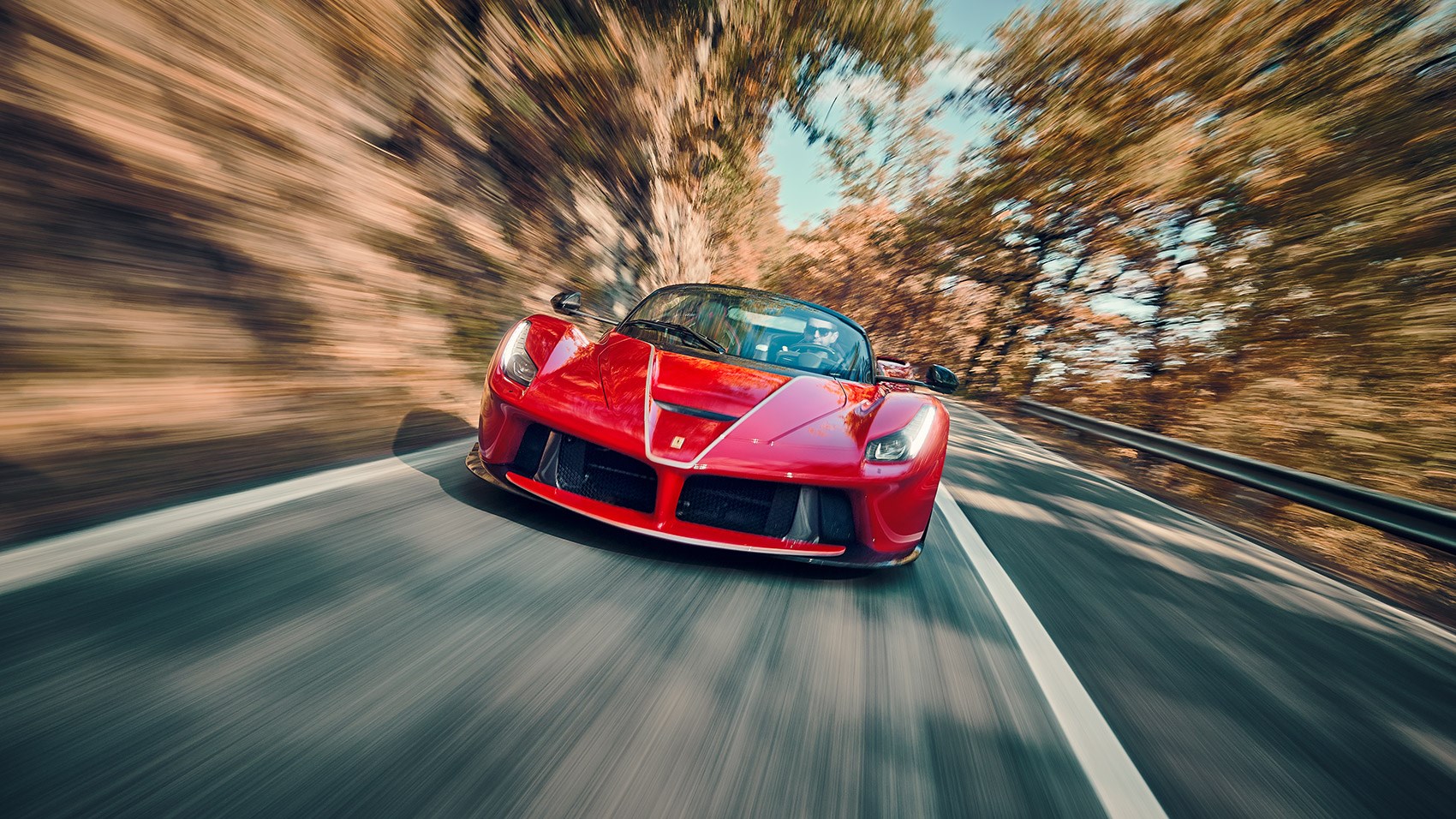
Running harder now into corners, leaving my braking later and turning-in with more speed and more ambition, if anything the Aperta just feels better. It clearly doesn’t speak understeer, and has little interest in learning the language. Instead the front just bites, you slowly shake your head in wonder and the car pivots like it’s weightless. Then, in a heartbeat, it’s that time: time again to depress that precision instrument of a throttle pedal; time again to revel in LaFerrari’s refusal to exhibit any delay between input and output; and time again to breathe deep, grip the wheel a little tighter and chase the V12 from apex right the way up to the thin air of nearly 10,000rpm.
You feel the rear tyres over-rotate like they’re wired to your brain, the car’s tail moving subtly but deliciously wide as all 950bhp chimes in to effectively flatten the next climb. This electrifying sense of connection works with the ultra-quick steering to make you feel like you’re right on top of the Aperta, able to read its every move and to be ready with the right thing to do should the call come.
The afternoon sun’s dropping fast, shadows sprinting across the valley as if on time-lapse. Cool air floods into the open cockpit, banishing any sense of fatigue after five blissful hours at the wheel. Completely in tune now with the car’s surreal abilities, this immersive, very three-dimensional road falls to the Aperta. It can’t summon a gradient savage enough to blunt the car’s speed, just as it can’t show us a complex of corners capable of defeating its astonishing chassis.
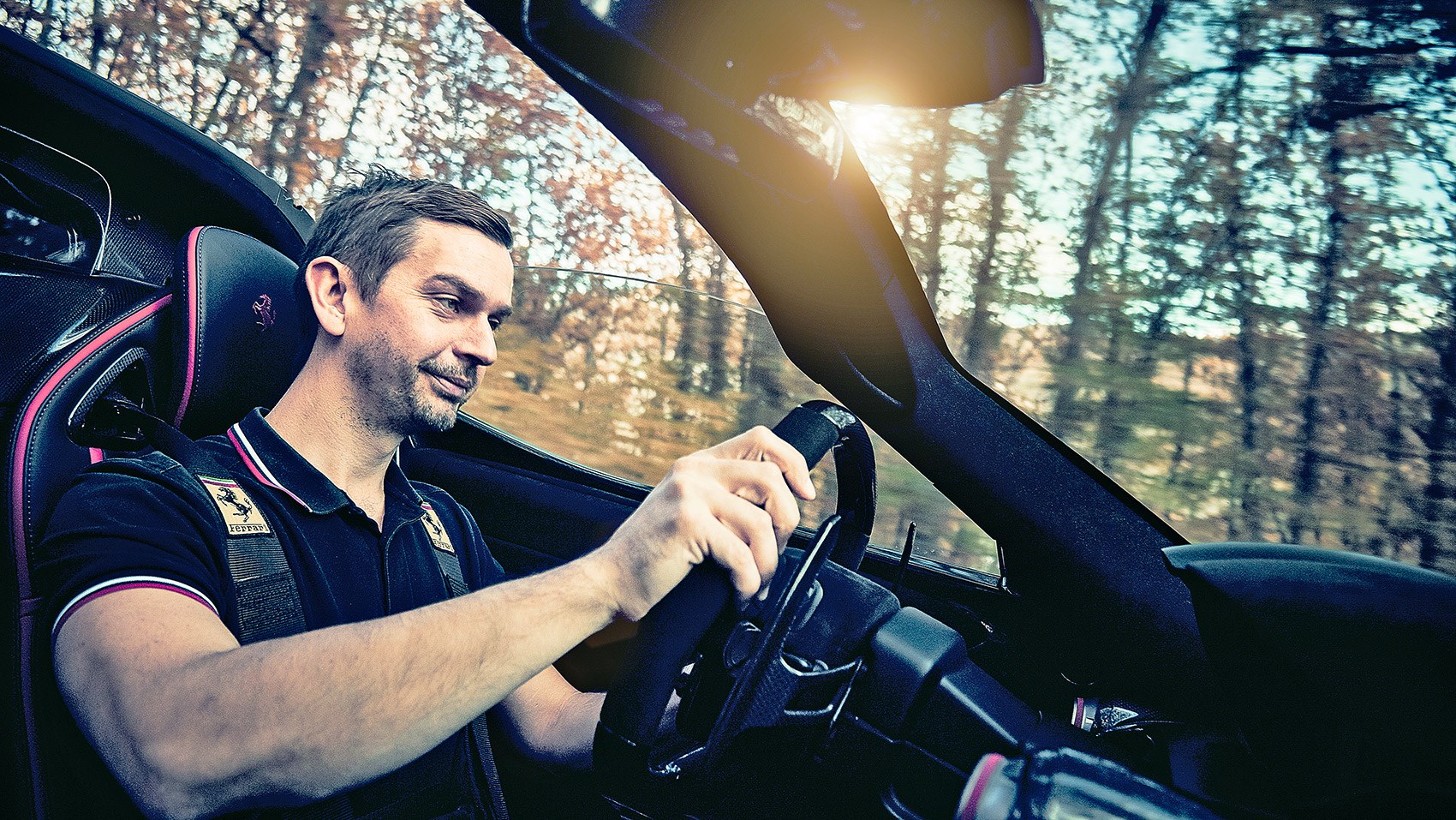
Where we come across it we’re past slower traffic before it even knows we’re there, their fleeting glimpse just the Aperta’s quite perfect rear end, shifting wing and active diffuser planes working away between glowing round tail lights.
To drive the Aperta is to find joy where you expect fear; confidence where by rights self-belief should desert you. Chief technical officer Michael Leiters insists that just as critical as raising the performance of Ferrari’s cars is increasing their owners’ ability to really drive them, and to enjoy them.
The LaFerrari is an astonishing embodiment of that philosophy. A machine of bewildering complexity, its defining brilliance is a driving experience of startling purity, one made magical by the unholy power and deviously clever electronics that could so easily have corrupted it. Miracle? No, just 70 years of practice.
More Ferrari reviews by CAR magazine